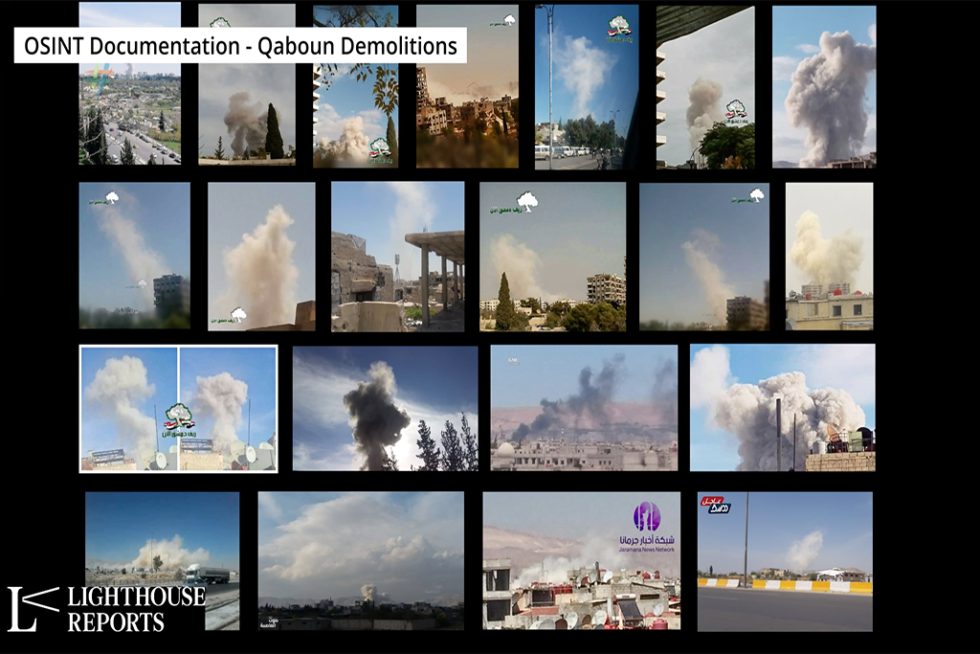
Syria’s Russian-Backed Demolition Campaign
Russian-led fake demining campaign a cover for community reprisals
Syrian forces, with the support of the Russian military, have demolished thousands of homes in the name of de-mining. Large parts of former opposition neighbourhoods in Syria have been reduced to rubble not through war, but the government’s “peace.”
In Damascus, the demolition campaign has concentrated on areas like Qaboun and Daraya that are in strategic locations and were the site of early protests against the government in 2011. They are also lucrative real estate — cheap land close to the city centre slated for redevelopment under controversial post-conflict planning rules.
Without homes or official ownership documents, former residents have little hope of ever returning to their neighbourhoods once they are rebuilt. Government blueprints indicate these areas will be transformed from working-class communities into high-end redevelopments designed to attract wealthy investors.
With Bashar al-Assad’s forces in control of most of Syria, some countries in the Middle East are moving towards closer ties with his government. If international sanctions are relaxed, regional companies are poised to reap significant profits from these reconstruction projects.
METHODS
While the government prevents most journalists and residents from entering these areas, we documented the extent of the destruction through analysis of satellite imagery, open source images of the demolitions, personal testimonies and photos, and tweets from the Syrian military.
Since September 2018, the Syrian military has announced nearly 1,000 demolitions across Syria on its Twitter account, saying they are necessary to remove explosive devices and tunnels “left behind by terrorist groups”.
Analysis of hundreds of images, videos and social media posts from Qaboun reveal an even greater number of demolitions and a pattern of large explosions that completely collapse buildings. Satellite analysis shows almost half of the buildings in Qaboun have been destroyed after fighting ended.
In partnership with Syrian Investigative Reporting for Accountability Journalism (SIRAJ) and Rozana Radio, we verified the date and location of a sample of the demolitions and found the owners of the destroyed buildings. While it was impossible to assess structural damage or the presence of explosives in each building, we spoke to a dozen Syrians whose homes were demolished in Qaboun who insisted they could have been repaired.
De-mining and international law experts who reviewed the images say they contradict Syrian and Russian official’s claims that these operations are necessary to keep civilians safe – in fact they could make the area more dangerous and constitute war crimes.
STORYLINES
The Russian military, which is training Syrian military engineers in de-mining and assisting with mine clearance operations on the ground in Damascus, describes these efforts as humanitarian.
Yet for over a decade of war, the Syrian government did not allow independent humanitarian groups to clear explosives, a delay described as unprecedented by one veteran official.
Talks were held up by international organisations’ concerns that the Syrian government would try to control who they can employ and which areas they are allowed to work in – issues that many NGOs have struggled with the Syrian government over for years. The government recently gave permission to the first major humanitarian organisation, Norwegian People’s Aid, to start a de-mining programme in Damascus this year.
Two former members of the Syrian military’s engineering units who now live in exile told Daraj media that their units are capable of removing explosives without demolishing entire buildings. An international de-mining expert said their current methods could actually make the area more dangerous by burying explosives under the rubble.
Under Syrian law, people whose homes are demolished because of war damage must be notified in advance, given a chance to dispute the assessment and compensated. None of the residents we spoke to were informed about the demolition or aware of any way to claim compensation.
“It’s a kind of revenge on the people of Qaboun and to make sure there is nothing to return to,” Mazena Saadi, a former driving instructor from Qaboun now living in Denmark, told The Guardian and Rozana Radio. “I think it is a message from the regime for the people of Qaboun. There is nothing for you here.”
Human rights groups warn the demolitions could breach international law. “The extent of the explosions is disproportionate to clean up tunnels and mines,” Sara Kayyali, senior Syria researcher at Human Rights Watch, told Trouw. “The government has retaken this area, there is no active fighting, no military target, it is disproportionate and therefore possibly a war crime.”
To keep up to date with Lighthouse investigations sign up for our monthly newsletter
The Impact
Our investigations don’t end when we publish a story with media partners. Reaching big public audiences is an important step but these investigations have an after life which we both track and take part in. Our work can lead to swift results from court cases to resignations, it can also have a slow-burn impact from public campaigns to political debates or community actions. Where appropriate we want to be part of the conversations that investigative journalism contributes to and to make a difference on the topics we cover. Check back here in the coming months for an update on how this work is having an impact.

